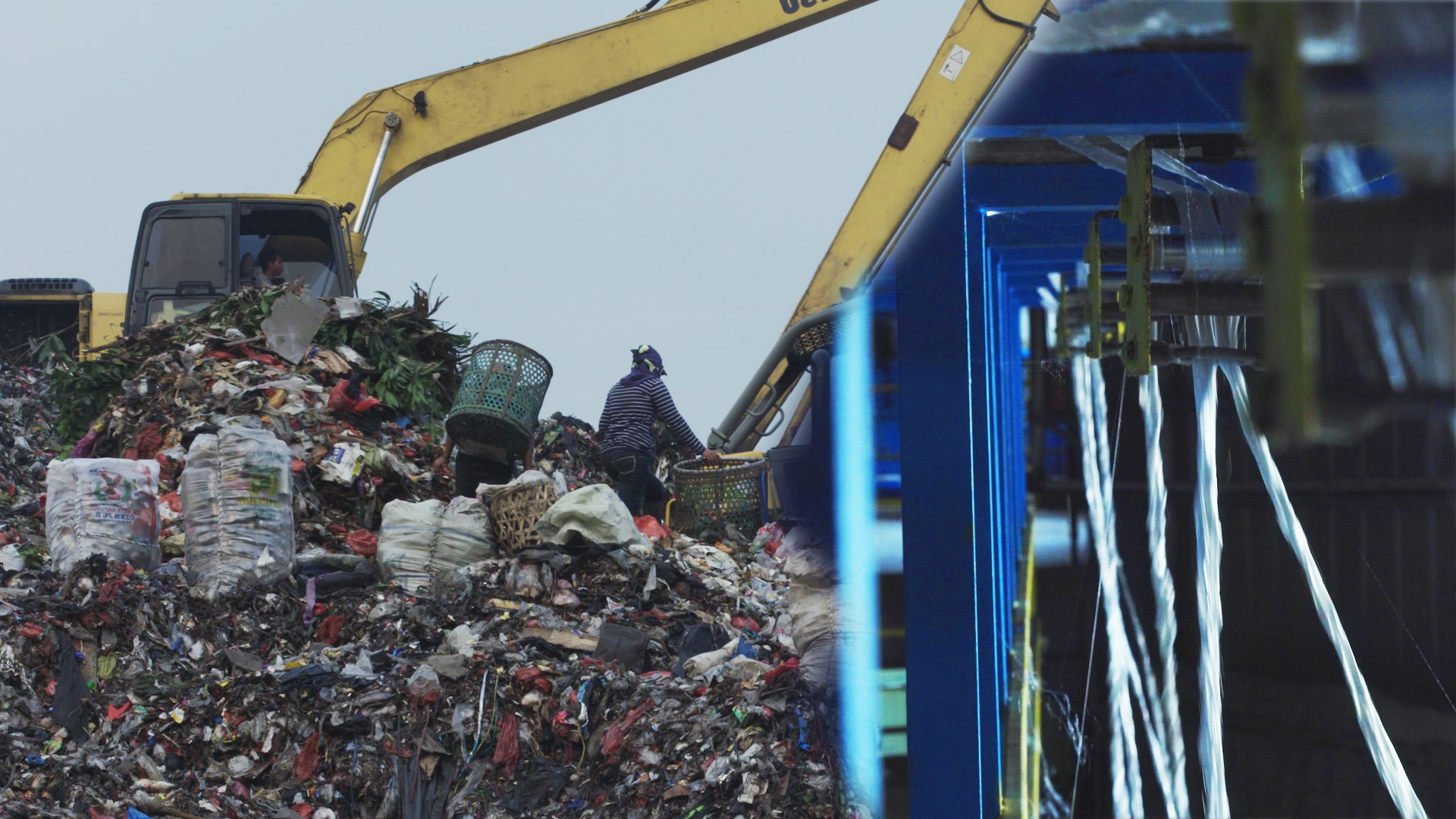This article originally appeared on VICE Indonesia.The “mountain” is apparent from afar, greeting onlookers with a swarm of flies and a pungent smell. Trucks line up from morning until afternoon, bringing to the dumpsite all the trash consumed by residents of Jakarta, Indonesia’s largest city. Bantargerbang is quite literally a mountain of trash.In September 2019, environmental activist and Hollywood actor Leonardo DiCaprio reposted on Instagram a painful photo from @natgeo of the Bantargebang dump in Indonesia, calling it the world’s largest. The photo shows trash collectors, known locally as pemulung, making a living in a sea of waste and plastic.
Advertisement
Long before Leo’s post, Bantargebang’s inability to hold more waste was already heavily reported. Every day, 6,500 to 7,000 tonnes of trash end up in Bantargebang. Without a viable method of processing this waste, the dump may shut down in 2021.
Due to the massive influx of trash, the Bantargebang landfill may only survive until 2021.
VICE made a documentary about plastic waste in Indonesia, but it’s difficult to imagine how bad the situation really is. So our writer in Indonesia paid a visit to the dumpsite to see what goes on at the world’s largest landfill.The line of trucks stretched from the road to the entry gate of the dump located in Ciketing Udik, Bekasi, just south of Jakarta. It doesn’t take long for each truck bringing waste from the capital to pass the weighing post and get into the landfill to dump their trash.Some reports say the mountain of trash was about 40 meters high in 2018. Edi Sudrajat, a dump worker, said no imported trash ends up here.The trash collectors climbing down the fragile mountain appeared to know every nook and cranny of the mountain and where not to step, as if it were their own backyard.But not all trash that ends up here is dry; some of it can be slippery to walk on. It seemed very possible for a trash collector to slip to his death from atop a mountain of trash.
It only takes a few minutes for trash collectors to climb down the 40-metre "mountain".
A 53-year-old who has depended on Bantargebang as a source of livelihood for six years, also named Edi, often searches for used tarp.When VICE asked him how he climbs the mound of trash, Edi, who like many Indonesians only goes by one name, said there are depressions in the mountain for him to step on, but slipping and falling onto something sharp is a common occurrence. He said the last time someone died of an accident in the dump was in January 2017, when a trash collector was suffocated by the collapse of a trash mountain.
Advertisement
“We slip a lot, especially when it rains. It’s summer now, but it’s not like this during the rainy season,” Edi said. “We stop [when it rains]. We are careful to watch where we step. When the wind is strong, we all come down from the mountain.”The endless stream of incoming and outgoing trucks leaves a lingering stench in the air, which the trash collectors, many of whom live inside the dump, deal with on a daily basis. An online taxi driver who lives near the dump told VICE that the smell is the worst in the afternoon, when it can travel dozens of kilometres.The Bantargebang landfill still relies on a system of open dumping, which involves dumping waste indiscriminately in any available area. However, Indonesia has laws prohibiting this dangerous method of dumping, as it can lead to the collapse of piles and the release of harmful chemicals into the air.For instance, overexposure to methane gas released by organic waste can be a threat to human health–even death–on top of being bad for the environment. Methane directly contributes to global warming because it can absorb 34 times more heat than carbon dioxide over a 100-year period.Sudrajat said residents receive Rp900,000 (US$63.87) in compensation known as “stink money” every three months – the cost of giving up their right to live with clean air.
Bantargebang resident living among trash.
No matter the season, life is difficult for Bantargebang’s trash collectors. The dust-filled air poses a risk to their respiratory system and their vision. Leachate water runoff from wet trash exposes residents to the risk of diseases like diarrhea.
Advertisement
The quality of water in the area is also questionable. Even though artesian wells have been built to cater to residents’ water needs, there is no guarantee that it is safe for daily use. While some residents use the well water confidently, others question whether liquid waste seeps into the wells. Sudrajat, who spends long days at the landfill, doesn’t trust the water. Despite the multitude of issues faced by the landfill, overload remains the most pressing problem. Jakarta’s waste management problem is like a time bomb. Realizing how critical the situation had become, the Environmental Department of Jakarta began implementing counter measures.One of the solutions is to work alongside Indonesia’s Research and Applied Technology Agency (BPPT) to build a thermally-powered waste-to-energy garbage power plant. According to local media, a pilot project for the plant was launched in March 2019 with the expectation that it would eventually be able to process 100 tonnes of garbage in a single day, therefore producing 700 kWh of electricity. Thermal power was the method of choice for this plant, as “Indonesians’ trash is mixed, contains high levels or organic material, high moisture, and low caloric levels,” according to Hammam Riza, head of the BPPT.The process involves the use of an incinerator, which Riza guarantees is environmentally-friendly. Information from the BPPT website explains that the garbage power plant at Bantargebang is equipped with three essential components that will minimize its environmental impact.
Despite the multitude of issues faced by the landfill, overload remains the most pressing problem. Jakarta’s waste management problem is like a time bomb. Realizing how critical the situation had become, the Environmental Department of Jakarta began implementing counter measures.One of the solutions is to work alongside Indonesia’s Research and Applied Technology Agency (BPPT) to build a thermally-powered waste-to-energy garbage power plant. According to local media, a pilot project for the plant was launched in March 2019 with the expectation that it would eventually be able to process 100 tonnes of garbage in a single day, therefore producing 700 kWh of electricity. Thermal power was the method of choice for this plant, as “Indonesians’ trash is mixed, contains high levels or organic material, high moisture, and low caloric levels,” according to Hammam Riza, head of the BPPT.The process involves the use of an incinerator, which Riza guarantees is environmentally-friendly. Information from the BPPT website explains that the garbage power plant at Bantargebang is equipped with three essential components that will minimize its environmental impact.

Advertisement
Trash collectors don’t get access to sufficient healthcare.
Firstly, the bunker is essentially a garbage storage unit equipped with a platform, a grab crane, and a reciprocating grate for incineration, allowing waste to be incinerated at temperatures exceeding 850 degrees Celsius. This minimises the formation of hazardous chemicals like dioxin and furan.The plant also features an Air Pollution Controller to filter harmful particles from the gas it produces. The final component is a pre-treatment unit that sorts out waste that is unsuitable for the incinerator, like metal, glass, rocks, and hazardous waste.The power plant is still being tested, and Riza hopes the incineration process will not release harmful particles into the air. VICE reached out to the BPPT to find out how effective the tests were, but did not receive a response.Meanwhile, some environmentalists believe the waste-to-energy plant is not the most efficient way to handle Jakarta’s mountains of garbage and will instead cause more environmental damage than the BPPT claims. They are now demanding that the government provide evidence that the land is suitable for such a plant and educate the public on the health risks before officially operating the plant.Fajri Fadhillah, a legal researcher in the Pollution Control and Environmental Damage Division at the Indonesian Center for Environmental Law (ICEL), said he has never seen an environmental impact analysis come out of Bantargebang’s garbage power plant pilot project. “The BPPT and Jakarta governments say they’ve done an environmental impact study on Bantargebang, but both of their websites, where such information should be available, have not published the studies. It should be public information,” Fadhillah said.
Advertisement
Muharram Atha, a campaign spokesperson at Greenpeace Indonesia, explained that half of Indonesians’ waste is household or organic waste, which are unsuitable for incineration. Dwi Sawung, a campaign spokesperson for the Indonesian Forum for the Environment (Walhi), said the process of incineration doesn’t fulfil one critical criteria: hazardous waste must be sorted out.Wet trash, according to Atha, costs more to incinerate. Unlike dry waste, wet waste must under pre-treatment before being incinerated. Additionally, the incinerator requires fuel for optimal results.“A garbage power plant must have a designated area for storage, as well as for the residue from incineration. The residue is known as ‘fly ash’ or ‘bottom ash,’” Fajri explained. The garbage plant itself can’t store this residue forever, for the sake of the health of people and the environment. “The ash itself must be processed further, a task that only a handful of waste management centres can do.”
The Conversation Indonesia reported that since the garbage power plant is thermally-powered, it may still release dioxin that can cause cancer, reproductive and developmental issues, immune system disorders, and hormonal disorders.Ultimately, both Atha and Fajri said that most appropriate solution to over-dumping is to reduce the amount of garbage Indonesians produce. Manufacturers too should make efforts to create products that produce less waste. An even better solution would be to stop using single-use, unrecyclable plastics altogether.It’s also essential for residents to stop wasting food and sort trash to make recycling easier – because once trash ends up in a mountain in a landfill, it’s practically impossible to reprocess."At this point, using less plastic won't really solve the problem entirely. We could be looking at a ban next if we're not careful," Fadhillah said.Sign up for our new Climate Coverage Now newsletter, in which we’ll bring together all of our best climate stories on a bi-weekly basis.
